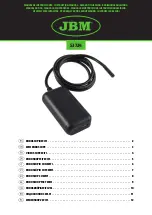
4-1
IM DLM3054-01EN
4 Triggering
Triggers are events used to display waveforms. A trigger occurs when the specified trigger condition is met, and
a waveform is displayed on the screen.
Trigger mode (Trigger Mode)
The trigger mode determines the conditions for updating the displayed waveforms. There are five trigger modes.
Auto Mode (Auto)
If the trigger conditions are met within a timeout period, the instrument updates the displayed waveforms on each
trigger occurrence. If not, this instrument automatically updates the displayed waveforms. The timeout period is
approximately 100 ms or the time corresponding to 10 divisions on the time axis, whichever is larger. If the time
axis is set to a value that would cause the display to switch to roll mode, roll mode display will be enabled.
Auto Level Mode (Auto Level)
If a trigger occurs before a timeout, the instrument updates the waveform in the same way that it does in Auto
mode.
If a trigger does not occur before a timeout, the instrument automatically changes the trigger level to the center
value of the trigger source amplitude, triggers on that value, and updates the displayed waveform. Auto Level
mode is valid when the trigger source is set to a channel from CH1 to CH4. For all other cases, Auto Level mode
operates in the same way as Auto mode.
If the time axis is set to a value that would cause the display to switch to roll mode, roll mode display will be
enabled.
Normal Mode (Normal)
The instrument updates the waveform display only when the trigger conditions are met. If no triggers occur, the
display is not updated. If you want to view waveforms that the instrument cannot trigger on, or if you want to
check the ground level, use Auto mode.
N Single Mode (N Single)
The instrument acquires signals each time the trigger conditions are met until a specified number of signals have
been acquired, and then displays all of the acquired signals. If no triggers occur, the display is not updated.
Single Mode
When the trigger conditions are met, the instrument updates the displayed waveform once and stops signal
acquisition. When you press SINGLE on the front panel, the instrument acquires waveforms in Single mode.
• The trigger mode setting applies to all trigger types.
• The trigger conditions that were used to acquire the displayed waveform appear at the upper right of the
screen.
• If you set the trigger mode to Auto when using a trigger combination, the timeout only applies to the trigger
A trigger conditions.
• If you are acquiring waveforms in Single mode when using repetitive sampling mode, waveform acquisition
is repeated until the required number of display points is collected, and then acquisition stops.
• Repetitive sampling mode is not available in N Single mode. If you select N Single mode when repetitive
sampling mode is selected, the sampling mode changes to interpolation.
















































